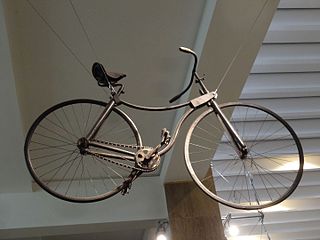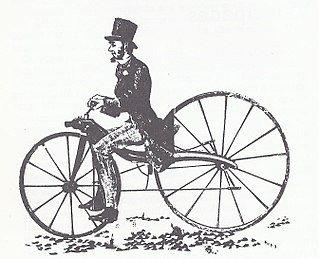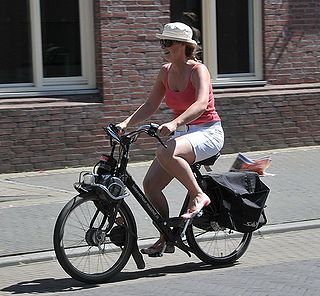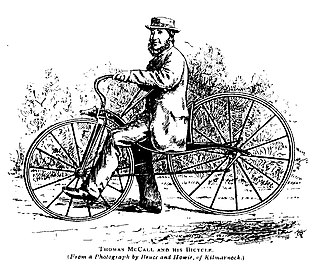
A bicycle, also called a pedal cycle, bike, push-bike or cycle, is a human-powered or motor-assisted, pedal-driven, single-track vehicle, with two wheels attached to a frame, one behind the other. A bicycle rider is called a cyclist, or bicyclist.

A tandem bicycle or twin is a form of bicycle designed to be ridden by more than one person. The term tandem refers to the seating arrangement, not the number of riders. Patents related to tandem bicycles date from the mid 1880s. Tandems can reach higher speeds than the same riders on single bicycles, and tandem bicycle racing exists. As with bicycles for single riders, there are many variations that have been developed over the years.

The penny-farthing, also known as a high wheel, high wheeler or ordinary, is an early type of bicycle. It was popular in the 1870s and 1880s, with its large front wheel providing high speeds, owing to it travelling a large distance for every rotation of the wheel. These bicycles had solid rubber tires and as a consequence the only shock absorption was in the saddle.

James Starley was an English inventor and father of the bicycle industry. He was one of the most innovative and successful builders of bicycles and tricycles. His inventions include the differential gear, the perfection of the bicycle chain drive, and the penny-farthing.

A velocipede is a human-powered land vehicle with one or more wheels. The most common type of velocipede today is the bicycle.

Vehicles that have two wheels and require balancing by the rider date back to the early 19th century. The first means of transport making use of two wheels arranged consecutively, and thus the archetype of the bicycle, was the German draisine dating back to 1817. The term bicycle was coined in France in the 1860s, and the descriptive title "penny farthing", used to describe an "ordinary bicycle", is a 19th-century term.

A safety bicycle is a type of bicycle that became very popular beginning in the late 1880s as an alternative to the penny-farthing and is now the most common type of bicycle. Early bicycles of this style were known as safety bicycles because they were noted for, and marketed as, being safer than the high wheelers they were replacing. Even though modern bicycles use a similar design, the term is rarely used today and is considered obsolete outside circles familiar with high wheelers.

Kirkpatrick Macmillan was a Scottish blacksmith. He is generally credited with inventing the treadle bicycle.

A monowheel or uniwheel is a type of one-wheeled, single-track vehicle. Unlike the unicycle, a monowheel consists of a large, hollow wheel that loops above and around the driver. Monowheels are typically powered by an engine as with a motorcycle, with a chassis securing the steering, driver's seat, and propulsion mechanism to the interior of the wheel.

A motorized bicycle is a bicycle with an attached motor or engine and transmission used either to power the vehicle unassisted, or to assist with pedalling. Since it sometimes retains both pedals and a discrete connected drive for rider-powered propulsion, the motorized bicycle is in technical terms a true bicycle, albeit a power-assisted one. Typically they are incapable of speeds above 52 km/h (32 mph), however in recent years larger motors have been built, allowing bikes to reach speeds of upwards of 72 km/h.
This timeline of motorized bicycle history is a summary of the major events in the development and use of motorized bicycles and tricycles, which are defined as pedal cycles with motor assistance but which can be powered by pedals alone.

Thomas McCall (1834–1904) was a Scottish cartwright.

The bike boom or bicycle craze is any of several specific historic periods marked by increased bicycle enthusiasm, popularity, and sales.
The history of the motorcycle begins in the second half of the 19th century. Motorcycles are descended from the "safety bicycle," a bicycle with front and rear wheels of the same size and a pedal crank mechanism to drive the rear wheel. Despite some early landmarks in its development, the motorcycle lacks a rigid pedigree that can be traced back to a single idea or machine. Instead, the idea seems to have occurred to numerous engineers and inventors around Europe at around the same time.

The following outline is provided as an overview of and topical guide to bicycles:

Bicycle drivetrain systems are used to transmit power on bicycles, tricycles, quadracycles, unicycles, or other human-powered vehicles from the riders to the drive wheels. Most also include some type of a mechanism to convert speed and torque via gear ratios.

The Michaux-Perreaux steam velocipede was a steam powered velocipede made in France some time from 1867 to 1871, when a small Louis-Guillaume Perreaux commercial steam engine was attached to a Pierre Michaux manufactured iron framed pedal bicycle. It is one of three motorcycles claimed to be the first motorcycle, along with the Roper steam velocipede of 1867 or 1868, and the internal combustion engine Daimler Reitwagen of 1885. Perreaux continued development of his steam cycle, and exhibited a tricycle version by 1884. The only Michaux-Perreaux steam velocipede made, on loan from the Musée de l'Île-de-France, Sceaux, was the first machine viewers saw upon entering the Solomon R. Guggenheim Museum rotunda in The Art of the Motorcycle exhibition in New York in 1998.

The Roper steam velocipede was a steam-powered velocipede built by inventor Sylvester H. Roper of Roxbury, Boston, Massachusetts, United States sometime from 1867 to 1869. It is one of three machines which have been called the first motorcycle, along with the Michaux-Perreaux steam velocipede, also dated 1867–1869, and the 1885 Daimler Reitwagen. Historians disagree over whether the Roper or the Michaux-Perreaux came first. Though the Reitwagen came many years later than the two steam cycles, it is often labeled as the "first motorcycle" because there is doubt by some experts whether a steam cycle should meet the definition of a motorcycle.

The American Star Bicycle was invented in 1880 by G. W. Pressey and manufactured by the H. B. Smith Machine Company in Smithville, Burlington County, New Jersey. It was characterized by a small wheel in front to avoid the problem of tipping forward inherent in other high wheelers. A Star bicycle was photographed being ridden down the steps in front of the United States Capitol in 1885 to demonstrate its longitudinal stability, and Star bicycles were used for the sport of bicycle polo in the mid-1880s. Pressey sued Smith in 1887 for royalties. The name "Star" was attributed to the double star arrangement of the spokes.

The Svea Velocipede was an early bicycle type invented in the 19th century by the Swedish brothers Fredrik Ljungström and Birger Ljungström.



























